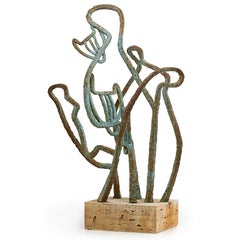Zoe Greene Mercier
1960s Cubist Abstract Sculptures
Travertine, Bronze
Recent Sales
Late 20th Century Cubist Abstract Sculptures
Bronze
1960s Cubist Abstract Sculptures
Travertine, Bronze
A Close Look at Cubist Art
Inspired by the nontraditional ways Postimpressionists like Paul Cézanne and Georges Seurat depicted the world, Pablo Picasso and Georges Braque pioneered an even more abstract style in which reality was fragmented into flat, geometric forms. Cubism majorly influenced 20th-century Western art as it radically broke with the adherence to composition and linear perspectives that dated back to the Renaissance. Its watershed moments are considered Picasso’s 1907 Les Demoiselles d’Avignon, in which nude figures are fractured into angular shapes, and Georges Braque’s 1908 painting show, which prompted a critic to describe his visual reductions as “cubes.”
Although Cubism was a revolutionary art movement for European culture, it was informed by African masks and other tribal art. Its artists, which included Fernand Léger, Alexander Archipenko, Marcel Duchamp, Juan Gris and Jean Metzinger, experimented with compressing space and playing with the tension between solid and void forms in their work. While their subjects were often conventional, such as still lifes, nudes and landscapes, they were distorted without any illusion of realism.
Cubist art evolved through different distinct phases. In Analytic Cubism, from 1908 to 1912, figures or objects were “analyzed” into pieces that were reassembled in paintings and sculptures, as if presenting the same subject matter from many perspectives at once. The palette was usually monochromatic and muted, giving attention to the overlapping planes. Synthetic Cubism, dating from 1912 to 1914, moved to brighter colors and a further flattening of images. This unmooring from formal ideas of art would shape numerous styles that followed, from Dada to Surrealism.
Find a collection of authentic Cubist paintings, prints and multiples, sculptures and more art on 1stDibs.
Finding the Right Abstract-sculptures for You
If you’re thinking about decorating your space with abstract sculpture, there are a couple of things to keep in mind.
You don’t have to look for a piece that demands attention. Find a work of abstract sculpture that speaks to you. As is the case with any abstract art, whether it’s sculpture, an abstract painting or a grouping of prints, you can select a work for your living room or dining room, for example, that will either casually fade into the background or serve as a focal point. When you’re thinking about how to arrange your furniture and decor, consider color, texture and what kind of energy you’d like a specific room or corner to evoke. Abstract sculpture can go a long way in elevating a home, and its history is interesting if you’re shopping for a new piece today.
As a pioneer in naturalistic forms and figures that vividly express emotion, Auguste Rodin is often called the father of modern sculpture. His work in the 19th and early 20th century broke with artistic conventions and inspired modernism, leading to a new period of avant-garde abstraction.
Among the first artists to push abstract sculpture into the mainstream were Pablo Picasso and Georges Braque. They helped define the movement of Cubism, which focused on deconstructing the world abstractly.
Later in the 20th century, the artistic movements of Italian Futurism, Dadaism, Neo-Dadaism, Surrealism, Abstract Expressionism and minimalism all contributed to the advancement of new and more abstract sculpture designs. Italian Futurism, for example, celebrated movement, dynamics and technology in abstract sculpture. These movements passed down ideas that continue to inform abstract sculpture today.
Browse a range of modern abstract sculptures, postmodern abstract sculptures and other kinds of sculpture on 1stDibs.


